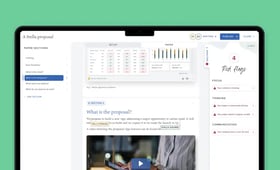This article is part of a series exploring the findings of our latest Board Report on stakeholder governance. You’ll find the entire series, including the research, at the end of this blog post.
Did you know that stakeholders are worth their weight in gold — literally?
Research conducted at Wharton found that — taking into account all extraction costs — the average listed gold-mining company trades at a 72% discount compared to the value of precious metal sitting in the mines it operates. The reason? A lack of stakeholder support.
The value of a gold mine [used to be] based on the amount of gold in the ground, the cost of extraction and the world price of gold. Today, I can show you two mines identical on these three variables that differ in their valuation by an order of magnitude. Why? One has local support and the other doesn’t.”
It’s not just mining, either. A growing body of evidence confirms what common sense suggests: that being considerate of your stakeholders is just good business and leads to long-term profits. In the United Kingdom, it’s even a legal obligation — while the country may not be famed for its underground lodes, every one of its boards must, by law, take into account the impact of its decision on its stakeholders.
But doing so in an effective fashion means more than the occasional board paper on suppliers or the environment. It requires making stakeholders an integral part of the decision-making process — something few boards manage to do today, according to both our latest research and the findings of others.
The majority of companies have not set up formal frameworks for ensuring the board is able to consider the interests of stakeholders within its decision-making process.”
Four questions to embed stakeholders into your board’s decision-making
1. Are stakeholders an integral part of our strategy?
Decisions don’t exist in a vacuum. They’re made according to an overall strategy that should guide every choice a board makes. So, by making that strategy itself hinge on stakeholders, stakeholder considerations become built into your decision-making.
Start by identifying the significant stakeholder issues already at play or still emerging — “the large-scale societal and environmental trends that may present risks and opportunities,” as Harvard Business Review puts it. How does your strategy fit within these, and is it relying on one or several of these trends to be successful? If not, even with the best intentions, there’s a good chance stakeholders will be crowded out of the discussion at some point.
Dialogue with stakeholders can help boards understand significant changes in the landscape, predict future developments and trends, and re-align strategy.”
Not all stakeholders and associated opportunities will rank in the same order of importance, and this will vary between organisations. Therefore, a prioritisation exercise will help you determine the groups and considerations that should be at the heart of your strategy and those that won’t drive success quite as much.
External drivers come first when we do strategic planning, then we look at how it impacts our six stakeholders. Are we missing any co-dependencies? Has everyone that’s going to be impacted been reflected in our thinking?”
Chair, Global Derivatives Trading House
Source: RBS’s annual report, via CGIUKI.
2. Do all decisions — not just the board’s — consider stakeholders?
The board is ultimately responsible for decision-making throughout the organisation, not just for the decisions made in the boardroom. And because there are a thousand decisions made throughout the business for every decision taken at board level, inadequate processes further down the ranks can quickly cascade into a crisis for directors.
Responsibility sits with the board, but the bulk of decision-making at the coalface is within management — there’s a disconnect.”
Chair, UK Pension Fund
If the board knows that success is contingent on its stakeholders, that view should become organisation-wide, and decisions at all levels should always be made through that prism. Yet, few organisations do so: 62% of the boards we surveyed say their organisational strategy doesn’t provide them with a valuable decision-making framework that can be used throughout the rest of the business.
Such a framework doesn’t have to be highly sophisticated, and may be as simple as a checklist. For example, the following questions that the FRC recommends boards ask themselves could be adapted for the rest of the organisation and ran through every time a team makes a decision:
Questions for boards
- Have relevant members of the executive team been invited to explain the issues at the earlier stages, enabling all directors to share concerns or challenge assumptions well before the point of decision?
- Does the board have a clear idea of the success criteria related to a particular decision?
- What are we doing to test key decisions for alignment with values? Can we give examples and explain how this was considered?
- What are the risks that the decision could encourage undesirable behaviours or send the wrong message?
- Can we explain how the impact on key stakeholders has been taken into account?
Source: FRC.
And because scaling up is what software excels at, use technology to ensure adoption throughout the business. Platforms like Board Intelligence can give you easy-to-use, automated tools to align discussions across all committees, monitor how much time is spent discussing specific stakeholders overall, and standardise the reports used to guide your decisions.
3. Are we recording how we reach decisions — and making use of it?
No one, least of all the regulator, expects boards to please every single stakeholder group continuously — they understand there are trade-offs. Sometimes, certain stakeholder interests will conflict with those of another group, or with what the organisation is trying to achieve, and that’s okay. What matters is that the decision was made with all the facts on the table and that boards can both evidence and communicate the decision-making steps to those concerned.
So, identify points of contact for your different stakeholders (union representatives, civil society groups, regulators…) and engage early and frequently with them about the calls you’ve made. By giving these stakeholders more context around the decisions taken — not just the “what”, but also the “how” and “why” — you’ll pre-empt potential misunderstandings and cultivate trust.
Stakeholders want to know how their interests have been taken into account. It is important companies establish feedback loops to show stakeholders how their views inform decisions.”
Crucially, these communication channels should be two-way streets. Don’t simply communicate your decisions to stakeholders; give them an unfiltered way to comment back to the board and use it to garner valuable feedback straight from the horse’s mouth. Were the assumptions you made about these stakeholders correct? If not, what went wrong in your decision-making, and how do you improve?
Established and formalised communication channels, as enjoyed by shareholders and regulators, can help embed the consideration of key stakeholder interests in board discussion and decision-making, and broaden directors’ understanding of stakeholder perspectives.”
4. Beyond representation at board level, is there understanding?
At its core, stakeholder governance is a matter of stakeholder awareness. In other words, it’s about answering a simple question: “Is the board equipped to understand the impacts of a particular decision in relation to all its stakeholders?”
Boards don’t have to be a perfect — or even approximate — representation of their stakeholders. But they must demonstrate awareness and understanding of these groups. And one of the most effective ways to do that is through the experiences directors bring in — or seek out.
The obvious answer is to make your board more diverse and representative. But that approach can only take you so far: Short of adding hundreds of directors, you can’t be a perfect mirror of society. So, in addition to bringing external knowledge onto the board, it’s up to boards to expand their thinking and find ways of broadening their experience.”
Alison Munro, Chair, National College for Advanced Transport and Infrastructure
Look at the past experience and the other roles held by your board members — such as sitting on the board of a charity, or holding an executive position at another organisation — and map these to your stakeholder groups. Are there gaps, with some groups not benefiting from the same level of expertise within the boardroom? If so, make it an important criterion for the next appointment at board or committee level, and find ways to upskill your directors. For example, if the executives have customer engagement sessions, why not have non-executives attend so they can get face-to-face experience with the customers?
Of course, skills and experience can only go so far if the data provided to the board members aren’t painting an accurate picture of your stakeholders. So, to find out what you should be monitoring and including in your board reporting, read our tips on how to identify the stakeholder metrics that matter.
Additional reading
- Board Intelligence — Navigating the New World of Stakeholder Governance
- Wharton — When Engaging with Your Stakeholders Is Worth Its Weight in Gold
- Deloitte — Hearing the stakeholder voice
- FRC — Guidance on Board Effectiveness
- CGIUKI and the Investment Association — The Stakeholder Voice in Board Decision Making



